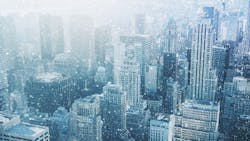Weakening Polar Vortex May Yield Longer, Harsher Winters
Citing a new study, AccuWeather reports longer, harsher winters may be in store for portions of North America as the polar vortex—a large pocket of frigid air that hovers above the polar regions and is most prominent during the winter months—continues to weaken and shifts.
Researchers at China's Lanzhou University penned the study, which was published in Nature Climate Change last month.
Lanzhou researchers found that a loss of sea ice in the Arctic regions attributed to rising temperatures in the Barents-Kara seas, along with an increase in snow cover over Europe and Asia, has caused the polar vortex to weaken. The pocket of cold air has, in turn, shifted toward Eurasia.
This movement could lead to colder and possibly extended winter seasons for portions of North America and Eurasia, according to the study.
"With warming and ridging in the Kara Sea, this typically allows for less ice cover, but also is a conducive atmospheric pattern for lower temperatures in the North American mid-latitudes," AccuWeather Meteorologist Edward Vallee said.
The polar vortex in winter can extend well into the atmosphere and at times be more than 100,000 ft deep, AccuWeather Senior Meteorologist Bob Smerbeck said.
A weaker polar vortex allows the stratosphere, or a distant part of the Earth's atmosphere, to warm, while a stronger one prevents that process, according to Vallee.
"The stratospheric vortex typically governs the tropospheric vortex (in the lower part of the Earth's atmosphere) during the winter months and is based on polar heating and cooling," Vallee said. "As the stratosphere warms in winter, it can reverse the wind direction below it."
This could block high-pressure systems from taking shape in the high latitudes of the Earth, which would increase opportunities for cold in the mid-latitudes.
According to Smerbeck, the southern shift could bring the other end of the polar vortex toward eastern North America, yielding colder winters for the region.
"There are other factors that determine where the vortex sets up," Smerbeck said. "The warm blob over the north Pacific in winter 2013-2014 and the unusually warm waters along the west coast of North America (for the) 2014-2015 winter contributed to a southward dip in the vortex across eastern North America and cold winters in the central and eastern U.S."
Smerbeck said a lot of research still is being conducted and that while some researchers may not find the latest study overly convincing, a mechanical connection between the lack of sea ice and the vortex shift, as opposed to just a statistical connection, should allow for more accurate modeling.
At times during the winter, a warm layer of air will develop high up near the stratosphere over eastern Asia and head toward the stratospheric vortex, causing it to weaken by being pinched, displaced, or even split. This will cause a portion of the stratospheric vortex to extend farther south.
A stronger polar vortex will hold the cold air northward. When it weakens and shifts away from the pole by squeezing, splitting, or displacement, it will drag cold air with it, Smerbeck added.
"Reduced sea ice over the Barents-Kara seas in the fall leads to a storm track that can increase snow cover over Eurasia and Siberia," he said.
"It has been shown that increases in Eurasian and Siberian snow cover in the fall can launch upper-level warming events that reach into the stratosphere and weaken the stratospheric polar vortex," he said, stating that this Arctic warming can weaken and alter the placement of the polar vortex.

